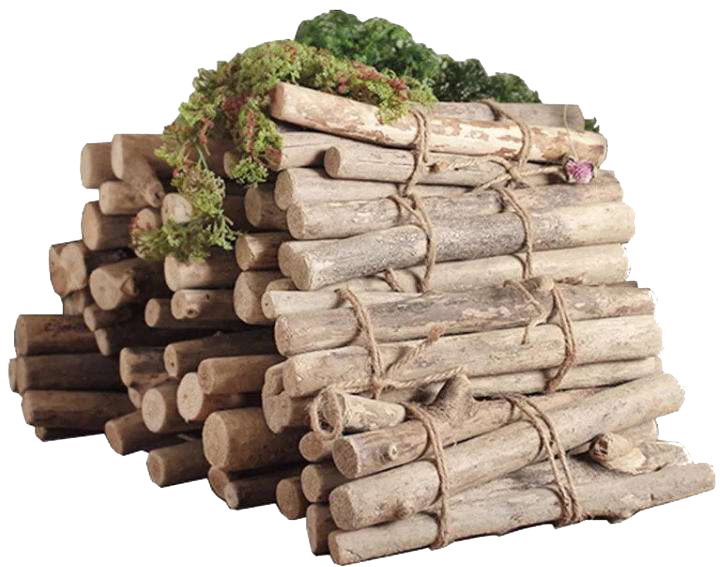
This is the stock preparation guide to pulping.
Pulping stock preparation is to process the fiber raw materials to remove the impurities and make them uniform, and then cut them into a certain size and shape of chips for later pulping work.
Generally, the wood used in pulping and papermaking has logs, waste wood, sap wood and slab paper. According to different pulping methods and quality requirements for pulping, the quality requirements for logs are also different, and the processes of stock preparation are also different.
Conventional procedures for wood chip preparation is to saw the logs into wood segments with appropriate length, do the peeling, chipping, screening and re-crushing for the latter. If the logs are too large in diameter, they need splitting by the splitter or a band saw first, and then are put into the chipper directly. When doing with a long round chipper, the logs can be put into the machine without segmenting. The screened long wood strips and large wood chips are broken into qualified wood chips by a crusher.
The preparation of grass raw materials is to provide a certain length of grass segments for digesting and remove a big part or most part of the ear piths, soil, sand and other impurities mixed in the grass.

Preparation process
Preparation Process and Quality Control
Conveying and storage of blanks
Chapter 1:
Preparation process
Material preparation is for reasonable storage, purification, and preparation of qualified tablets, which can meet the needs of continuous production. Wood-based raw materials are usually stored for 3 to 6 months; grass-based raw materials are stored for 6 to 9 months; bagasse is usually stored for 6 to 9 months. The storage time will be slightly longer depending on the species with high resin content (such as Yunnan pine), the distance and method of transportation. Remove some impurities that are useless for papermaking.

1.Water Storage
It can save the heavy lifting operation, increase the height, and evenly distribute the water to prevent the wood from spoiling.
2. Ground Storage
It can reduce the moisture and resin of the logs. If it is in a higher environment, the masson pine will easily rot and produce blue.
Preparation of wood raw materials

Chapter 2:
Preparation Process and Quality Control
Preparation of wood raw materials
1. Sawing of logs
2. Peeling of logs
3. Knocking and chopping of logs
4. Wood and board shavings
Preparation of non-wood raw materials
1. Preparation of rice straw raw materials
2. Preparation of raw materials such as reeds, cormorants, awns, etc.
3. Preparation of bamboo raw materials
4. Preparation of bagasse raw materials



The general wood grinder requires a log length of 0.6m or 1.2m, and an ordinary chipper is 2.0-2.5m
Production Process:
Log horizontal transport → Log vertical transport → Log peeling → Log transport → Log truncation → Log transport
1. Ring peeler

2. Cylinder peeling machine

Cylinder peeling machine is a kind of friction peeling machine. It is peeled by rubbing and rubbing the logs in the vertical interior. Due to friction peeling in the gearbox, the layer peeling machine is a kind of equipment accessories.
Working principle of Cylinder peeling machine:
The transmission mechanism of the coaxial peeling machine rotates in series around the horizontal axis through gear drive. The wooden sections in the tube extend and rotate and are lifted to a certain height and then fall down, so that the wooden sections in the tube, the wooden section and the lifter, and the tube wall Strong repeated collisions and frictions occur between the knife shaft or the peeling tool, and the bark on the surface of the long log is impacted, squeezed, and sheared to be peeled.
The replacement of a tandem body by the centrifugal force caused by the log’s axial movement and its own gravity displacement is called critical. Under the condition of normal filling factor, when the subdivision is below 0.4nk, the logs in the tube will fall intermittently; at (0.4-0.8) nk, the logs in the tube will fall continuously; at (0.8 -0.85) nk At that time, the logs in the tube began to be thrown upward, that is, the transition from the collapse type to the waterfall type.
When the log’s movement in the cylindrical shape changes from the fall type to the waterfall type, the impact tilt and compression force continue to rise, while the shear stress drops sharply, which adversely affects the peeling effect. Shearing, the loss of the log has increased, so the correction of the classification is generally not more than 0.8nk under the normal filling factor. When the fill factor is low, for example, 0.4, and when (0.7-0.75) nk is reached, the log starts to transition from the fall type to the waterfall type.
3. Hob peeling machine

Main technical specifications and parameters:
1.Maximum length of processed logs 2700mm
2.Diameter of processed logs Φ200-Φ800mm
3.Total motor power 26.4kw
4, cutter head speed 1460rpm
5.Cutting head speed 0.8-13m / min
6.Conveyor speed 27.9m / min
7.Rated oil pressure 4Mpa
8.Machine weight: 7500kg
9.Air pressure 0.6Mpa

The wood splitter can split stumps, large branches, large round wood segments and harder wood to meet the requirements of the size of the chipper, or split the raw materials into materials for other purposes.
Wood splitting machine is an important auxiliary equipment in the wood chip processing industry. It uses hydraulic working principle and mainly has two series: vertical and horizontal. The general stroke specifications are 1000㎜, 1100㎜, 1200㎜, nominal pressures are 30 tons, 35 tons, 50 tons, etc. It is more convenient to use the horizontal model, and can be made as a traction mobile machine according to user needs.
Horizontal wood splitter, shear wood splitter: It is suitable for manufacturers of wood chips such as board making and paper making. It is an ideal product to assist in the production of wood chip equipment. It is the latest domestic wood splitter series.
How wood splitters work
Wood splitter is the simplest hydraulic equipment commonly used today. The wood splitter contains all the basic components of a hydraulic machine:
The engine, usually a small four-stroke gasoline engine, powers the entire system. The engine is connected to a hydraulic oil pump.
The hydraulic oil pump generates a high-pressure oil stream and injects it into the valve.
The operator can operate the hydraulic cylinder to split the wood by pulling the valve.
At the same time, there is also a tank containing hydraulic oil to fill the oil pump at any time, and a filter is installed to keep the oil clean.
Wood splitter parameters
The general stroke specifications are 1000㎜, 1100㎜, 1200㎜, nominal pressures are 30 tons, 35 tons, 50 tons, etc. It is more convenient to use the horizontal model, and can be made as a traction mobile machine according to user needs.
Performance characteristics of wood splitter
Wood splitter is an indispensable device for the initial processing of wood. Because of different regions and different names, they can be divided into the following types: vertical wood splitters, also known as trowel wood splitters, gantry wood splitters, splitters, horizontal wood splitters, and so on.
Trowel-type wood splitter: It is suitable for manufacturers of wood chips such as board making and paper making. It is an ideal product to replace the band saw.
Horizontal wood splitter:
1.Motor power: 17kw
2. The wood splitter runs flexibly, smoothly and efficiently.
3. Small footprint, convenient maintenance 4. Splitting wood 3-5 tons per hour
Product function: reasonable structure, sturdy and durable, high output, easy operation, safety and other characteristics, it is an ideal product to replace the band saw.
Vertical wood splitter:
This type of equipment is a medium and large-scale wood splitting machine. It has the characteristics of reasonable structure design and convenient operation. It is the first choice for enterprises and personal wood chip processing households. It is a special product for cracking large tree roots and special thick branches. It is suitable for MDF plants, artificial board plants, papermaking, bio power plants, etc.
Safety operation matters of the wood splitting machine: Check the machine for foreign body blockage every time before use to avoid the danger of jamming the machine; during the use process, safety protection facilities should be set up to keep the body balanced when fingers are 5 cm away from the blade; When the blade of the wood splitter needs to be replaced, the power lamp should be turned off before the machine stops running and then approach.

For wood pulping, the specifications of wood chips: 15-25mm in length, 3-7mm in thickness, 5-20mm in width, 90% pass rate
Dry preparation:
Cutting:
Knife roller lawnmower: feeding, cutting grass, conveying grass
Screening and dust removal
Grains, dust, blades of grass, and grass sections entrained in the film
The equipment used is: roller dust collector, double cone grass dust collector, water film dust collector
All wet preparation-NACO, Sweden
Advantage:
Eliminate flying dust and improve the environment
Reduce noise and labor intensity
Improve the quality of grass
Reduce drug use
Increase yield, strength
Blade cutting reed machine, reed dry and wet combined material preparation process
Chip preparation: knife roller bamboo cutter, double-layer cylindrical bamboo sieve
Tear removal and marrow preparation-developed by American Peadco
Demyelination
Semi-wet method: about 50% water, dry method: 25% water, wet method: about 5% concentration
Chapter 3:
Preparation Process and Quality Control



9/F, Building 2, Huaqiang New Times, Xian’ge Avenue, Hi-Tech Industry Development Zone, Anyang, Henan, China